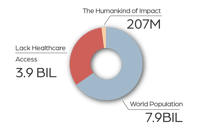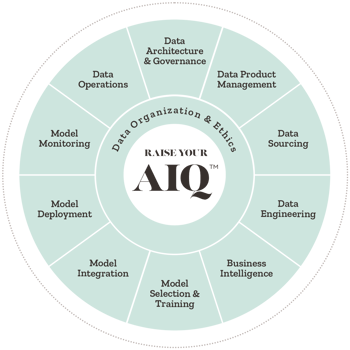Too Much Data, Too Little Time: A Business Case for Dimensionality Reduction
Introduction to Dimensionality Reduction
High-Dimensional Data
Imagine a spreadsheet with one hundred columns and...
for the health of people

for the health of planet

for the health of business

|
FOR THE HEALTH OF PEOPLE: EQUITY
|
 |
|
“The work [with Synaptiq] is unprecedented in its scale and potential impact,” Mortenson Center’s Managing Director Laura MacDonald MacDonald said. “It ties together our center’s strengths in impact evaluation and sensor deployment to generate evidence that informs development tools, policy, and practice.”
|
| Read the Case Study ⇢ |
|
DATA STRATEGY
|
 |
|
A startup in digital health trained a risk model to open up a robust, precise, and scalable processing pipeline so providers could move faster, and patients could move with confidence after spinal surgery.
|
| Read the Case Study ⇢ |
|
PREDICTIVE ANALYTICS
|
 |
|
Thwart errors, relieve in-take form exhaustion, and build a more accurate data picture for patients in chronic pain? Those who prefer the natural albeit comprehensive path to health and wellness said: sign me up.
|
| Read the Case Study ⇢ |
|
MACHINE VISION
|
 |
|
Using a dynamic machine vision solution for detecting plaques in the carotid artery and providing care teams with rapid answers, saves lives with early disease detection and monitoring.
|
| Read the Case Study ⇢ |
|
INTELLIGENT AUTOMATION
|
-1.jpg?width=296&height=196&name=man-wong-aSERflF331A-unsplash%20(1)-1.jpg) |
|
This global law firm needed to be fast, adaptive, and provide unrivaled client service under pressure, intelligent automation did just that plus it made time for what matters most: meaningful human interactions.
|
| Read the Case Study ⇢ |
 |
|
Mushrooms, Goats, and Machine Learning: What do they all have in common? You may never know unless you get started exploring the fundamentals of Machine Learning with Dr. Tim Oates, Synaptiq's Chief Data Scientist. You can read and visualize his new book in Python, tinker with inputs, and practice machine learning techniques for free. |
| Start Chapter 1 Now ⇢ |


The business research firm Gartner describes data strategy as “[the] process employed to support the acquisition, organization, analysis, and delivery of data in support of business objectives.” In other words, it’s the collection and application of data for your organization. One might say that data strategy makes your work work for you.
How? Think about your organization. It’s not perfect. That’s a given; pain points, errors, slowdowns, breakdowns — they’re guaranteed in every organization. The challenge isn’t determining whether they exist (they do!). It’s why.
Let’s imagine that you have an underperforming department. The solution seems simple and obvious: Perform better! But the question is, How? Your department could be understaffed, under-resourced, poorly managed, etc. A million things could be going wrong, and you won’t fix the real problem until you find the needle in the haystack.
The solution is easy. Figuring out how to do it is harder. This is true for just about every business problem.
Until recently, organizations had only one way of problem-solving: the manual approach. Let’s test it on your underperforming department. You might start by hiring a few extra staff. If that doesn’t improve performance? Add more resources. Change management. Rinse and repeat until the department isn’t underperforming.
The manual approach is problematic because it wastes two things:
While you’re throwing solution-spaghetti at the wall, hoping that something will stick, your department is still underperforming — AND eating up the cost of failed solutions. If only you had some way to figure out how to implement the solution in a more timely, cost-efficient way, right? We have great news: data strategy is that way.
Data strategy lets your organization approach problem-solving with the advantage of being quantitatively and qualitatively informed about the problem. If your organization had collected data on department performance and turned that data into a performance analytics dashboard, you would better understand why your department was underperforming before trying to figure out how to solve the problem, saving you time and money.
Data strategy can also help you identify why processes are going right (and how to make them even better). For example, it can help your organization identify opportunities, reach its target consumers more efficiently, implement cutting-edge technology, measure success across its initiatives, and more with actionable insights.
We’ve established that having a data strategy is a big deal. Now we’ll explain how to make one.
It starts with communication.
When roommates make house rules, they talk about it because they’re all affected. When countries make treaties, they talk about it because they’re all affected. Processes with many stakeholders can’t happen unilaterally.
When your organization makes its data strategy, the process shouldn’t be unilateral. You can’t leave it up to one person, department, or branch. You don’t want to finish your data strategy only to learn that the "X" data collection method doesn’t work for the “Y” department or that the “B” data application sucks for the “C” project. Your data strategy affects everyone in your organization, so everyone must have a voice in its construction.
However, you should not approach data strategy as a democratic free-for-all. You want your data strategy to be collaborative, not glacial. You want it to work for everyone while also not indulging in everyone’s pet projects, personal biases, or other business. You can achieve this by following Synaptiq’s three-step approach, which we’ve refined with more than a decade’s experience assisting organizations with their data strategies:
The best way to collect “enough” but not “too much” internal input on your data strategy is to appoint leaders who will represent the interest groups within your organization. We recommend recruiting from director-level (and higher) positions in the areas listed below. Note that certain areas may be more (or less) important than others, depending on your organization’s particular circumstances. Use your best judgment!
Additionally, we suggest that your leaders consult regularly with your chief executive officer (or equivalent). Their input is vital for two reasons. First, the CEO has the highest-level view of your organization’s workflow and priorities, which is a unique and valuable perspective. Second, they likely wield significant decision-making influence over internal funding, which you must secure in order to undertake a successful data strategy endeavor.
Your next step is to assemble a team to synthesize the internal input you’ve collected into a data strategy. When Synaptiq assists an organization with its data strategy development, we administer internal assessments to gauge its maturity in 11 data capabilities (AIQ™), then work with a team to normalize and contextualize the results.
Who should be a member of your team? In a word, enthusiasts. Synthesizing raw, diverse input into a cohesive data strategy is a time-consuming, intense, and potentially tedious labor of love. Your team will lose interest in the process (resulting in a worse final product!) unless passion makes them genuinely invested in a great outcome.
We've already touched on the importance of internal funding. In this third step, it becomes essential. Once you’ve chosen your leaders and team, you need resources to put them into action. But who’s footing the bill?
Documenting your organization’s motives and existing means for data strategy development will help you convince financial gatekeepers that it’s worth funding. You can’t take out a loan showing how you’ll pay it back and why you want it! You can’t fund a data strategy without showing how it’ll work and why it’s worth it.
We recommend prioritizing the following information:
Documentation is a litmus test to gauge the efficacy of the previous two steps. You haven't done enough prep work if you can’t describe how you will create and implement a data strategy and why it will have a positive return.
Data strategy development doesn’t have to be an internal process. It’s entirely possible that your organization may not want to hire the in-house specialists needed to fully realize a data strategy. Harvard Business Review considers data science “the sexiest job of the 21st century” because its technical practitioners command cost-prohibitively high salaries. That’s not to mention the data architects, data governance leaders, data engineers, and data operations folks who also play a non-negotiable role in developing even the simplest data strategy.
Consulting firms like Synaptiq offer a timely and cost-effective alternative to the in-house hires you would need to hire for data strategy development. Decades of experience make our experts the best at what they do, with a price tag that reflects work (not training!). If your organization is interested in exploring data strategy development or wants to optimize a process already underway, consider reaching out to Synaptiq. We’ll help you succeed.

Synaptiq is an Oregon-based AI and data science consulting firm. We engage our clients in a collaborative approach to developing custom, human-centered solutions with a commitment to ethics and innovation.
Contact us if you have a problem to solve, a process to refine, or a question to ask.
You can learn more about our story through our past projects, blog, or podcast. our past projects or blog.
High-Dimensional Data
Imagine a spreadsheet with one hundred columns and...
April 25, 2024
Sentiment analysis is a useful tool for organizations aiming to understand customer preferences, gauge public...
February 28, 2024
In the ever-evolving landscape of technology, innovation and experimentation are key drivers of success. However, the...
February 23, 2024